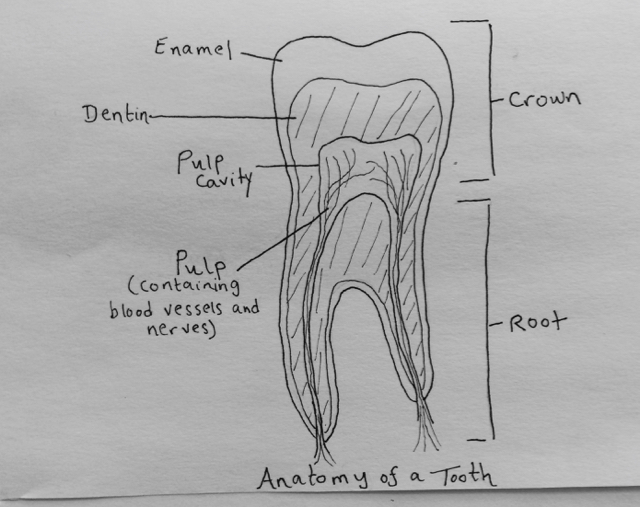Sometimes it feels like there is a tiny timpani playing inside your molar. Its constant beat is almost calming and it radiates a sort of warmth. The dental assistant says Oops, we have to do one more X-ray, open wide, and the dentist says, Looks like we’ll have to do a root canal, which isn’t a very big deal, don’t worry. Sorry, denticle drummer, we’re going to have to let you go.

Commonly called a root canal, endodontic therapy is a type of treatment for the damaged insides of a tooth. Its name comes from the Greek, with the roots endo meaning “inside” and odont meaning “tooth.” The expedition inside the tooth is to remove infected pulp, which is in an area called the pulp chamber. Tooth pulp is vivacious. It is composed of living tissue, blood vessels, and cells with the name of a superhero: odontoblasts. The pulp’s primary function is to form dentin, which is the layer above the pulp chamber and helps protect the tooth. It is also nutritive (it keeps the surrounding mineralized tissue happy with nutrients and moisture) as well as sensory.
When the pulp becomes inflamed or infected it becomes sensitive (very—your tongue trains the coffee away from the tooth and you throw the rest of the Junior Mints in the trash) and it must be removed from its chamber. To do this, the well-paid endodontist creates an opening called an access cavity in the tooth’s crown and uses a root canal file to clean out nerve tissue, bacteria, toxins, and other debris. After the putrid pulp is removed from the chamber and root canals, a rubber compound called gutta-percha is inserted to seal the tooth.
Gutta-percha comes from a tree of the same name (Latin palaquium gutta). The natural latex produced from the sap of these trees has been used for sundry industrial and domestic purposes, most notably as insulation for underwater telegraph cables. It is a very flexible material, happy under the ocean or inside a tooth’s pulp chamber. Once the gutta-percha is placed to keep the tooth from being reinfected with bacteria, the access cavity is then filled with either a temporary or permanent crown (depending on how robust the patient’s insurance plan is) and the process is complete.
At the end, you’re out some dental pulp and about $1,000 but you’re the proud owner of a wad of gutta-percha and you can drink coffee without flinching.


I enjoyed all the posts, both those from Mindy and from Josh. Mindy’s “Sorry, denticle drummer, we’re going to have to let you go” is classic (as is Mindy’s ability to appreciate dental visits). And now in Esperanto, according to Google Translate:
Mi ĝuis ĉiujn afiŝojn, ambaŭ de Mindy kaj de Josh. La “Sorry, denticle drummer” de Mindy, ni devos lasi vin iri “estas klasika (kiel la kapablo de Mindy por estimi dentajn vizitojn).
Talked to the author and it turns out all the artwork is hers. (Dentists around the world: pay her royalties!)